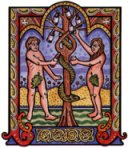"Forbidden Fruit"
(or reasons why drinking age should be lowered)
by Ruth Clifford Engs, '61

Ruth C. Engs, "Forbidden Fruit." Vermont Quarterly, Winter 1999:25 & 47, 1999. Art work and article used by permission from University of Vermont. (c) Copyright, Board of Trustee's University of Vermont, 1999-2001 Burlington, VT. Used by permission. http://hdl.handle.net/2022/17465
As UVM and other universities work to address student alcohol abuse, one of the greatest hindrances they face is the fact that the legal drinking age is set at twenty-one, an age most college students won't reach until their junior or senior years.
This perspective is built upon more than two decades studying college student drinking patterns and the history of alcohol use in this country and other cultures. My research has led me to believe strongly that perhaps the simplest and most dramatic action we could take to create more responsible alcohol consumption among college students would be to lower the legal drinking age to eighteen or nineteen. Young adults should be allowed to drink in controlled environments such as restaurants, taverns, pubs and official school and university functions. In these situations - where mature and sensible drinking behavior would be expected - responsible alcohol consumption could be taught through role modeling and educational programs.
Although the legal purchase age is twenty-one years, a majority of college students under this age consume alcohol - certainly not a surprise to anyone. When they have the opportunity to drink, they do so in an irresponsible manner because drinking by these youth is seen as an enticing "forbidden fruit," a "badge of rebellion against authority" and a symbol of "adulthood." As a nation we have tried prohibition legislation twice in the past for controlling irresponsible drinking problems, during National Prohibition in the 1920s and state prohibition during the 1850s. Because they were unenforceable and because the backlash towards them caused other social problems, these laws were finally repealed.
Prohibition did not work then and prohibition for young people under the age of twenty-one is not working now.
The flaunting of the current laws is readily seen among our nation's university students. Those under the age of twenty-one are more likely to be heavy -- sometimes called "binge" -- drinkers (consuming more than five drinks at least once a week). For example, 22% of all students under twenty-one compared to 18% over twenty-one years of age are heavy drinkers. Among drinkers only, 32% of under age compared to 24% of legal age are heavy drinkers.
Research from the early 1980s until the present has shown a continuous decrease in drinking and driving related variables which has paralleled the nation's, and also university students, decrease in per capita consumption. However, these declines started in 1980 before the national 1987 law which mandated states to set the legal purchase age at twenty-one.
The decrease in drinking and driving problems are the result of many factors and not just the rise in purchase age or the decreased per capita consumption.These include: education concerning drunk driving, designated driver programs, increased seat belt and air bag usage, safer automobiles, lower speed limits, free taxi services from drinking establishments, etc.
While there has been a decrease in per capita consumption and motor vehicle crashes, unfortunately, during this same time period there has been an increase in other problems related to heavy and irresponsible drinking among college age youth. Most of these reported behaviors showed little change until after the legal age was mandated at twenty-one in 1987. For example from 1982 until 1987 about 46% of students reported "vomiting after drinking." This jumped to over 50% after the law change. Significant increases were also found for other variables: "cutting class after drinking" jumped from 9% to almost 12%; "missing class because of hangover" went from 26% to 28%; "getting lower grade because of drinking" rose from 5% to 7%; and "been in a fight after drinking" increased from 12% to 17%.
This increase in abusive drinking behavior is due to "underground drinking" outside of adult supervision in student rooms and apartments where same-age individuals come together in the 1990s collegiate reincarnation of the speakeasy.
Based upon the fact that our current prohibition laws are not working, alternative approaches taken from the experience of cultures who do not have these problems need to be tried. In Europe, two different drinking cultures developed in antiquity. In the Mediterranean regions, wine consumption with meals by all members of the culture evolved, along with a norm of moderation. In the more northern and eastern regions of Europe, drinking to intoxication of grain-based beverages at feasts emerged, along with ambivalence towards alcohol.
Groups such as Italians, Greeks, Chinese, and Jews, who have few drinking related problems, tend to share some common characteristics. Alcohol is neither seen as a poison or a magic potent, there is little or no social pressure to drink, irresponsible behavior is never tolerated, young people learn at home from their parents and from other adults how to handle alcohol in a responsible manner, and there is societal consensus on what constitutes responsible drinking.
We can learn from this. Because the twenty-one year old drinking age law is not working, and is counterproductive, it behooves us as a nation to change our current prohibition law and to teach responsible drinking techniques for those who chose to consume alcoholic beverages.

